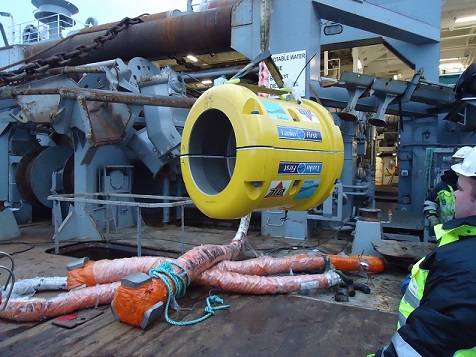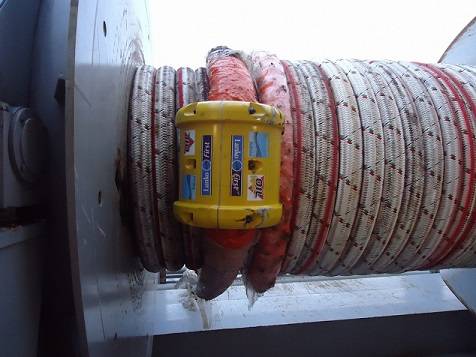Lankofirst Trials New Fiber Rope Connectors
Lankofirst said offshore trials of its synthetic fiber rope mooring connector have shown a reduction in mooring line deployment times and improvements in health and safety compared with traditional mooring line plate links and thimbles, reports deepwater mooring rope specialist, Lankhorst Ropes Offshore Division (LROD).
The cost and complexity of deploying deepwater moorings is driving the development of new mooring line technologies and deployment methodologies. Lankhorst, in collaboration with LROD worldwide agent, Offspring International and subsea mooring connector specialist First Subsea, has developed the Lankofirst fiber rope connector specifically for deepwater fiber connections. Smaller, lighter, stronger and more efficient than current plate links and thimbles, the Lankofirst is easier to make-up and the rope splice slimmer and lighter for the same MBL. The Lankofirst can be used for all fiber rope mooring connections including rope-rope, rope-wire and rope-chain connectors.
The recent trial offshore Norway has shown that the Lankofirst connector can be assembled in 15 minutes, compared with at least 1 hour 15 minutes for a traditional shackle. In addition only two people are needed to assemble the connector, unlike a shackle which usually requires three people, requiring fewer people on deck during hazardous line make-up operations.
The Lankofirst fiber rope connector is made from forged steel using First Subsea's research into optimal steel grades for long-term deepwater subsea mooring connectors. The company was the first manufacturer of offshore mooring connectors to achieve American Bureau of Shipping's ABS 2009 Approval for specialist subsea mooring connectors covering the design and manufacture of large scale forgings over 500mm in diameter.
In place of a large spliced soft eye normally used with H-link and shackle connections, the Lankofirst uses a sub-connector Donut which is integrated into the rope termination during manufacture. The innovative and smaller donut splice is much easier to handle offshore.
For maximum installation flexibility, the Lankofirst is offered with clam, snap and link connections. The offshore trials used the clam design, and the snap and link are in development. The connection is made by inserting the two rope sub-connectors into the open clam, and then bolting the clam shut. This contrasts with the assembly of the shackle connection which involved inserting the shackle into the splice eye and then hammering in the large diameter retaining bolt.
In addition to developing the Lankofirst fiber rope connectors, Lankhorst Ropes and Offspring International have also identified improvements in deployment methodologies to reduce the time, complexity and cost of installing deepwater mooring systems.
During mooring installation or hookup operations, the mooring line is preloaded to induce permanent elongation in the rope (sometimes called construction stretch or bedding-in) and increase its stiffness. Once all the mooring lines are connected they are pre-tensioned. Traditional approaches to preloading synthetic rope mooring lines have been based on 40% MBS (Minimum Breaking Strength).
Given industry concerns about the rising cost of performing deepwater installations, and mooring ropes with MBSs rising to over 2,500T, a new methodology to both rope pre-loading and pre-tensioning has been developed to reduce the high cost and safety issues surrounding excessive pre-loading. The traditional approach to preloading is based on rope testing at fixed loads and variable length.
A better method is to use fixed length ropes that are preloaded to 30%, and subsequent storms providing the final line tensioning to 40%. This approach to mooring system deployment enables significant reduction in the size of installation vessels, and time needed to deploy moorings. It is also better suited to the practicalities of deploying stronger synthetic mooring lines needed for ultra-deepwater moorings, which will be beyond the scope of existing installation vessels.
Recently the concept of lower pre-loading has being taken a stage further by considering the case of a FPSO mooring. In this instance, pre-tensioning is proposed without the need for installation vessels, other than for deployment and hook up, relying instead on deballasting and ballasting the vessel to provide the pre-tensioning needed to install the mooring lines.
"The lower pre-loading approach is consistent with the viscoelastic nature of synthetic ropes. All we are doing is using the fiber's ability to recover its original length after the 40% storm loading to complete the final installation," said Dave Rowley, director, Offspring International Ltd.
www.lankhorstropes.com














